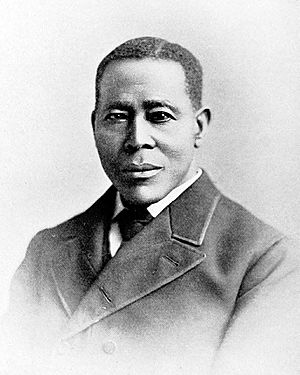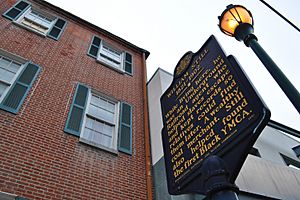William Still facts for kids
Quick facts for kids
William Still
|
|
|---|---|

Image of Still, published in 1898
|
|
| Born | October 7, 1821 |
| Died | July 14, 1902 (aged 80) |
| Resting place | Eden Cemetery (Collingdale, Pennsylvania) |
| Occupation |
|
| Known for |
|
| Spouse(s) |
Letitia George
(m. 1847) |
| Children | 4 |
William Still (October 7, 1821 – July 14, 1902) was an African-American abolitionist from Philadelphia, Pennsylvania. An abolitionist is someone who worked to end slavery. William Still was a "conductor" on the Underground Railroad, a secret network that helped enslaved people escape to freedom. He helped about 650 people find their way to Canada.
Still was also a successful businessman, a writer, a historian, and a civil rights activist. Before the American Civil War, he led the Vigilance Committee of the Pennsylvania Anti-Slavery Society. This group directly helped people escaping slavery. William Still kept careful records of everyone he helped. He did this so that families separated by slavery could find each other again later. After the war, he used these notes to write a very important book called The Underground Railroad Records (1872).
Contents
William Still's Family and Early Life
William Still was born in Shamong Township, Burlington County, New Jersey. His parents were named Sidney (later called Charity) and Levin Still. Both of them had been enslaved. William was the youngest of eighteen children!
His parents had escaped slavery separately. His father, Levin, bought his freedom in 1798 and moved to New Jersey. His mother, Charity, escaped twice from Maryland. The first time, she and four of her children were caught and forced back into slavery. A few months later, Charity escaped again, taking only her two younger daughters. She finally reached her husband in New Jersey.
Even though William and his younger siblings were born in New Jersey, a free state, some laws still considered them enslaved because their mother had escaped. However, New Jersey law said they were free. They settled in a small area of New Jersey called the Pine Barrens.
Charity and Levin could not free their two older sons, who remained enslaved in Maryland. One son, Levin Jr., died while enslaved. Another son, Peter Still, escaped slavery when he was about 50 years old. He later sought help from the Pennsylvania Anti-Slavery Society. There, he met William Still, not knowing they were brothers. As William listened to Peter's story, he realized it was the same story his mother had told him. William was so surprised and happy to find his brother! Peter and his mother were reunited after 42 years.
William also had a brother named James Still. James was born in New Jersey in 1812. He wanted to be a doctor but faced challenges because of his race. James studied plants and herbs and learned medicine from a white doctor. He became known as the "Black Doctor of the Pines" in Medford Township. James's son, James Thomas Still, was one of the first African Americans to graduate from Harvard Medical School in 1871.
Marriage and Children
In 1844, William Still moved from New Jersey to Philadelphia, Pennsylvania. In 1847, he married Letitia George. They had four children who lived past infancy.
- Caroline Virginia Matilda Still (1848–1919) became a pioneering female medical doctor. She studied at Oberlin College and the Women's Medical College of Philadelphia. Caroline had a large private medical practice in Philadelphia. She was also a community activist and teacher.
- William Wilberforce Still (1854–1932) graduated from Lincoln University and became a lawyer in Philadelphia.
- Frances Ellen Still (1857–1943) became a kindergarten teacher. She was named after the famous poet Frances Ellen Watkins Harper.
- Robert George Still (1861–1896) became a journalist and owned a print shop.
William Still's Activism
Fighting for Freedom
In 1847, William Still started working for the Pennsylvania Anti-Slavery Society. He became the leader of the Vigilance Committee in Philadelphia. This committee directly helped people who had escaped slavery and reached the city. William and his wife, Letitia, even used their home as a secret stop on the Underground Railroad from 1850 to 1855.
In 1855, Still was involved in a famous rescue. He helped Jane Johnson and her two sons gain their freedom. Jane was traveling through Philadelphia with her enslaver. Under Pennsylvania law, if an enslaver brought enslaved people into the free state, those people could choose to be free. Jane chose freedom. Still and others were sued, but Jane returned to Philadelphia to testify in court. Her testimony helped Still and others win their case.
William Still also fought against unfair rules on public transportation. In Philadelphia, streetcars had separate seating for white and Black people. Still worked hard to change this. In 1865, a law was passed that made streetcars across Pennsylvania open to everyone, no matter their race.
The Underground Railroad
William Still was called "The Father of the Underground Railroad" by The New York Times. He helped as many as 800 enslaved people escape to freedom. He carefully interviewed each person, writing down their story, their destination, and any new names they used. He kept these records hidden. He knew they would be important for helping families reunite later, just like he reunited with his own brother, Peter.
Still worked with many other brave people who helped on the Underground Railroad. This network reached from the South, through Delaware, Maryland, and Pennsylvania, all the way to New Jersey, New York, New England, and Canada. Famous "conductors" like Harriet Tubman passed through Still's office with people seeking freedom. Still also helped friends of John Brown after Brown's raid on Harpers Ferry in 1859.
After the Civil War
During the American Civil War, William Still helped run a store at Camp William Penn. This was a training camp for African American soldiers. He also opened a stove store and a coal delivery business, which he continued after the war.
In 1872, Still published his famous book, The Underground Railroad Records. This book was based on the secret notes he had kept for years. It tells the stories of many people who escaped slavery and the brave people who helped them. The book was very important for understanding how the Underground Railroad worked. Today, you can read it for free online.
Business and Helping Others
After the war, William Still continued to be a successful businessman and a generous person who helped his community.
He owned a large public hall called Liberty Hall, which was one of the biggest public spaces owned by a Black person in the U.S. He also invested in a newspaper and was part of Philadelphia's Board of Trade. He helped start and fund groups that tracked freed people.
Still was active in the Colored Conventions Movement, which worked for equal rights for African Americans. He believed in equal education for all. He also supported the temperance movement, which encouraged people to avoid alcohol. He helped establish a mission school for the Presbyterian Church. He was also involved with organizations that helped formerly enslaved people and cared for elderly and sick Black people.
William Still cared deeply about young Black people. He helped create an orphanage and the first YMCA for African Americans in Philadelphia. He also served on the boards of other homes for children and became a trustee at Storer College.
Death and Legacy
William Still passed away on July 14, 1902, at his home in Philadelphia. He was buried in Eden Cemetery in Collingdale. This cemetery is the oldest African-American owned cemetery in the nation. In 2018, the house where Still lived from 1850 to 1855 was recognized as a historic place in Philadelphia.
His Family Today
William Still's personal papers were given to the Charles L. Blockson Afro-American Collection at Temple University Library. Researchers can still study them today.
Some of William Still's relatives include famous athletes like WNBA player Valerie Still and NFL player Art Still.
National Recognition
In 1997, the U.S. Congress passed a law to create the National Underground Railroad Network to Freedom program. This program helps identify and celebrate sites connected to the Underground Railroad. This law recognized William Still's huge importance as a leader of the Underground Railroad.
See also
 In Spanish: William Still para niños
In Spanish: William Still para niños


